
How to Grow Huge Cannabis Buds
Every cannabis seed grower knows that the most crucial step in a successful harvest is to get their plants to grow the biggest and most potent buds possible. However, accomplishing that goal is quite a challenge. Through trial and error, we have discovered a few basic ideas that, when understood properly, will help you grow bigger buds. Here, we will look at some of these concepts and show how they can be applied in your California or Minnesota growing space.
A Brief Introduction to Cannabis Buds
Though cannabis plants have many beneficial parts, buds are the most recognizable. The buds (flowers) contain THC, which gives marijuana its potent psychoactive effects. THC is also found in the plant’s leaves, albeit in smaller quantities. Because the buds contain more THC than any other part of the plant, it is only natural that they get the most attention from growers and consumers.
Cannabis plants go through several life stages, including vegetative and flowering phases. Buds emerge during the flowering stage, but the vegetative stage is equally important. During this time, proper cultivation techniques lay the foundation upon which healthy, robust buds grow.
Why is Marijuana Bud Size So Important?
Though we already know that buds are rich in THC, they also contain a rich assortment of other cannabinoids with medicinal benefits. When buds emerge during the flowering stage, growers know that harvest time is drawing near.
While a cannabis plant’s sugar leaves are covered in THC-heavy trichomes, there is much more in the buds. That is why growers are so proud of the sticky, dank buds the plant yields after months of dedication and effort. When growing smaller plants from autoflower seeds, growers will want to especially focus on these techniques in order to maximize the value of their crop.
Many mistakenly assume that male plants do not produce smokable buds. Male buds look much different, and although they can produce potent weed, it is not as powerful as that coming from a female plant. The biggest problem is that male plants pollinate females when they are grown together. With cross-pollination, female plants produce less THC and more seeds. Experienced growers tend to separate plants by gender and only use male cannabis plants for seed production. Female plants yield buds about two weeks later than male plants do. In this comprehensive guide, we will show how lighting, training, feeding, pruning, and other factors help grow larger buds.
Finding the Highest-Quality Seeds
The biggest buds start with the best seeds. Selecting the right seeds for a grow op is one of the biggest decisions a grower will make. The success of the harvest depends on it! As a cultivator, you probably already know how crucial it is to buy top-quality feminized cannabis seeds from a reputable seed bank like Kind Seed Co. However, it goes much deeper than that, and not all top-shelf strains will work in every garden.
Late-blooming, stretchy Sativa strains are not the best choice for small grow ops. Autoflowering and Indica varieties are a much better fit for these growers. Additionally, landrace cannabis strains are better for outdoor growers than other, less hardy strains. A successful home growing op is about synergy more than anything else, and by choosing the right strain for the growing environment, you are more likely to produce big, sticky, and potent buds. Our selection of 710 seeds are specialized with high percentages of cannabinoids to make good quality cannabis oil and concentrates. You can also grow enormously big buds that will not get your high with our CBD-dominant seeds. The choice is yours, but always choose a trusted source for your seed purchase.
Regulating pH
For a female cannabis plant’s root system to efficiently absorb nutrients, the growth medium’s pH must be precise. You cannot achieve fat and juicy colas if the pH is off. Coco and hydroponic growers should aim for a pH of 5.5-6.0; the soil is a bit more forgiving and it allows for a pH of up to 6.5. Invest in a pH pen or pH-precise nutrients to eliminate the guesswork that comes with monitoring.
Making Buds Grow Faster
As obvious as it may seem, the most basic rule of cultivation is the faster buds grow, the bigger they will be at harvest time. Once you have accepted and understood this fact, you can think of ways to accelerate the growth of your plants’ buds. Thankfully, there is more than one way to go about it, and we will explain some of these methods in the sections below.
Pruning
The easiest and best way to get cannabis plants to grow faster during the flowering stage is to remove dead and dying leaves. It is easy to tell which leaves are in poor condition because they will turn yellow. These leaves will not bounce back, so it is okay to remove them.
These sickly leaves, if left untended, will affect the speed of bud growth. Why is this the case? While the leaves are still on the plant, they drain away resources that could be used to grow healthy buds. Therefore, removing these leaves will give you the best chance at the big, fat buds you are seeking.
After removing the plants’ dead and dying leaves, do not throw them away. Cure and dry them because they contain enough cannabinoids (such as THC) for effective use in tinctures, oils, and other cannabis products.
Another type of pruning, known as topping, is an effective way to accelerate the growth of cannabis buds. It is simple to do; just cut off some of the bud growth at the top of the plants. These buds will not go to waste, as they can be cured and smoked or made into edibles, but their removal allows other buds to grow faster and sooner.
Training
Low-stress training or LST is another method. There is no removal or cutting of plant material involved; rather, you will move the plants in ways that affect their growth patterns. With LST, plants will grow wide and bushy rather than skinny and tall. Bending is sometimes used in LST, but the plants’ stems are not broken.
The most important part of successful LST is to start when the plants are relatively young. The screen of green is another low-stress training option that uses nets to maintain plants’ growth patterns and shapes. With this method, plants take in the most light possible, improving growth speed and efficiency during every life stage.
Proper Nutrition
When the plants enter the flowering stage, they will need a revamped nutrient regimen. Growers should remember that cannabis plants need more phosphorus during the flowering phase than in the vegetative stage, so select a fertilizer blend with 30% phosphorus, 10% nitrogen, and 10% potassium for the best results.
It is sometimes hard to find a ready-made blend with that much phosphorus, so supplementation may be necessary. Water and wood ash should provide enough phosphorus for flowering plants. As a rule, good feeding practices will help the plants grow bigger, fatter buds.
Lighting
In an indoor cannabis garden in Arizona or Colorado, there is much a grower can do with lighting to affect the speed of bud growth. Light intensity is a vital component; the more intense light the plants receive, the bushier they will be and the faster the buds will grow. It is easy to increase lighting intensity by moving the lights closer to the crop. For maximum growth, be sure the light is shining directly onto the buds.
Darkness
Cannabis plants start to bud when they get at least 12 hours of darkness each day. After the flowering stage begins, the plants must be kept on the same cycle or they may shift back into the vegetative state and the size of the buds may be limited. Once the plants are on a 12/12 lighting schedule, it may take six to 10 weeks before those big buds are ready to harvest. Be prepared with a plan to darken out your greenhouse if you plan to grow outdoors in Florida, where the fall days can run a little longer than the more northern states.
Carbon Dioxide
Carbon dioxide or CO2 accelerates plant growth in general, and marijuana plants are no exception. By combining intense light with CO2 supplementation, it is possible to get the fat, aromatic buds everyone wants. Carbon dioxide increases the efficiency of plant growth and the absorption of light, making it a great addition to a grow op. Please keep in mind that, while added carbon dioxide is beneficial to plants, it is dangerous for people and it should be used carefully.
Humidity and Temperature
The most important aspect of humidity and temperature is to monitor it regularly and keep it within the appropriate range for the cannabis strain. This is crucial not just during the plants’ flowering stage but in all life stages. To get bigger buds, be sure the humidity and temperature are adjusted according to each growth stage.
Watering
Though water is crucial to healthy plant growth, it is possible to get too much of a good thing. If the plants’ leaves look droopy, they are probably getting too much water. Overwatering often leads to nutrient deficiencies and leaf yellowing, as the plants’ roots are not absorbing enough oxygen to properly metabolize the water and nutrients they are getting. This, in turn, leads to slower bud development.
Container Size
As the saying goes, bigger is better. However, that logic does not always apply to cannabis growing ops. Choosing the right size container for the plants will help them reach their full potential in the shortest time possible. Though many growers go for the biggest container, that is not always the best choice. Here, it may take the plants’ root system longer to find the nutrients it needs, and the roots may not work all the way through the soil. By using smaller containers, it is possible to grow more plants in the same space.
Choosing too-small containers is equally risky, as it may stunt plant growth by limiting the space in which the root system grows. Though small containers maximize efficiency and allow the roots to find nutrients faster, they do not always allow those roots to fully develop. Stunted growth brings smaller buds.
To get bigger buds, you will have to choose the right size container for the cannabis strain. Most plants grow by 40-60% in height during the flowering stage, so they will need plenty of room. Kush, Haze, and hybrid strains tend to have longer flowering periods, so they may need bigger containers than faster-flowering skunk strains. At kindseed.com, you will find high-quality auto-flowering and feminized seeds from some of the world’s most well-known cannabis strains.
Harvest Timing: It is Essential
No matter how slow or fast the buds grow, harvest timing is a crucial step in maximizing bud size and quantity. The last two or three weeks of growth may add upwards of 25% to the potency and size of the buds. For this reason, it is important to let the buds grow as long as possible before harvesting them.
Conversely, delaying the harvest for too long may mean that the buds will be past their prime. Though the timing is, to an extent, dictated by personal preference, it is important not to harvest too late or too early. The timing of the harvest determines not just bud size, but potency.
Plant Genetics
As in other aspects of cannabis cultivation, bud size is largely dictated by genetics. If you are starting off with low-quality, cheap seeds or some found in a bag of weed, the resulting plants and harvest might not be that successful. However, by paying careful attention to genetics and buying the highest-quality seeds you can afford, the chances of a successful crop are greatly increased.
Drying and Curing
If the plants’ buds do not feel heavy during the flowering and harvest stages, there is a way to increase their density. Drying and curing the buds after a successful harvest may add a bit of density, as well as potency, aroma, and taste. When curing and drying the buds, do not move too quickly. Put them in a sealed glass container, such as a one-quart wide-mouth Mason jar. With a bit of patience and the right curing method, you will get the big, flavorful buds everyone loves.
A Few Closing Thoughts on Growing Big Buds
If you are serious about growing cannabis, cultivating it so it has the largest possible buds should be a top priority. Healthy, large buds are filled with beneficial cannabinoids such as THC, but it is important not to assume that you will meet your goals by following a simple guide.
Regardless of what anyone says, gardening is a tough skill to master. Growing cannabis plants is no exception, and it is unlikely that the first crop will produce monstrous buds. With patience, dedication, and effort, as well as the consideration of the factors in this guide, a grower can get the results they are seeking. Once you perfect this skill and decide to expand the size of your cannabis garden, be sure to check out our exceptional pricing on wholesale seeds as well.



